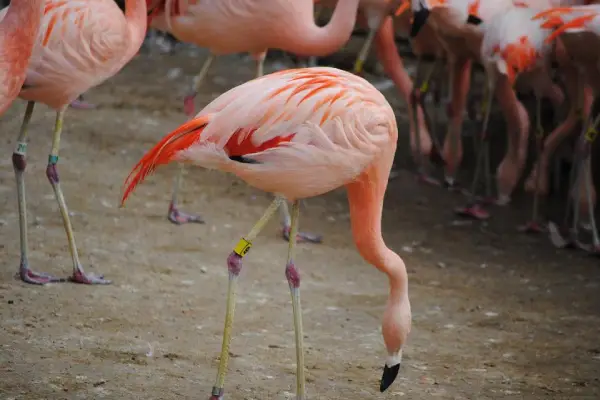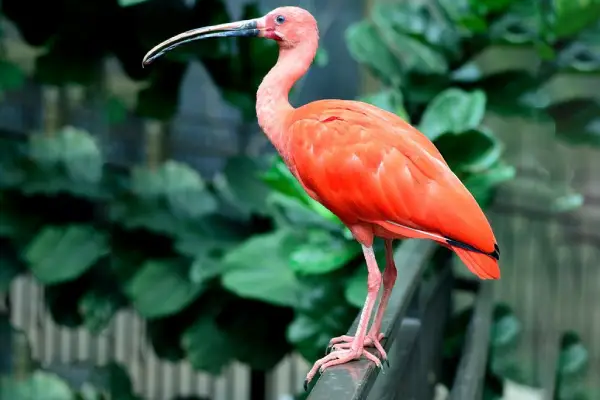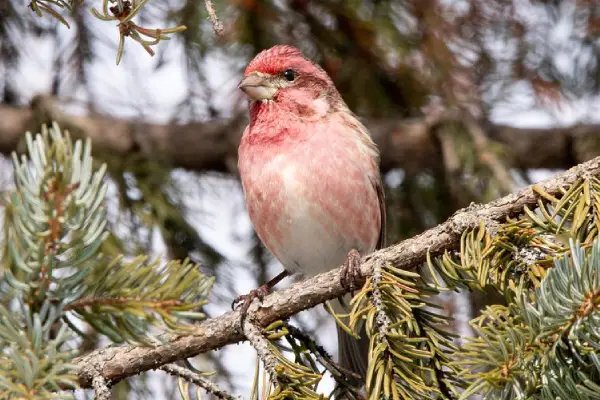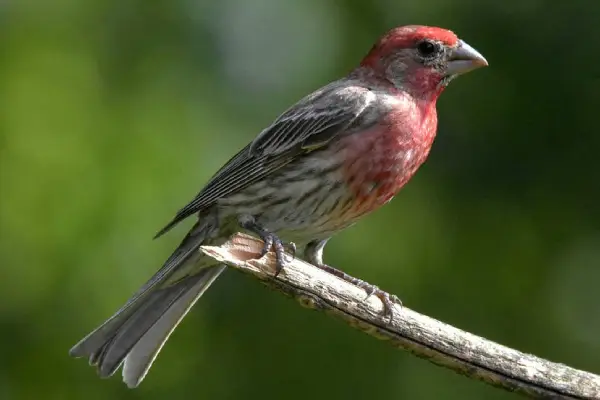Living in Florida and saw some pink birds but are not sure which ones they were?
Florida is known for its wildlife, and according to the Florida Ornithological Society Records Committee (FOSRC), there are over 500 species of birds there.
Examples of pink birds in Florida include the American flamingo, roseate spoonbill, scarlet ibis, purple finch, and house finch.
Some, like the roseate spoonbill, can be seen in the state throughout the year, while others, like the purple finch, will only come during winter (nonbreeding season).
Here are their photos and some fun facts.
Table of Contents
Pink Birds In Florida
American Flamingo

- Scientific name: Phoenicopterus ruber
- Lifespan: 20-30 years
- Wingspan: 59 in
- Range In Florida: South Florida
American flamingos are giant pink birds with very long necks and legs. These wading birds are mainly pink with red wing coverts and black primary and secondary flight feathers. They also have pink beaks with black tips and pink legs.
American flamingos can be found in South Florida and the Florida Keys. The best time to see them there is from March to May, although some populations might stay in Florida Bay year-round.
The best places to see American flamingos in Florida are along the coast: in Hialeah, the Everglades, Biscayne Bay, and the Florida Keys.
They are also easy to identify by their call which sounds like a goose honking.
American flamingos can grow up to 5 feet tall, weight up to 8 pounds, and have a wingspan of up to 5 feet.
They are also named “rosy flamingos” and get their color from the food they eat.
American flamingos are omnivores that feed on algae, small seeds, and aquatic invertebrates such as brine, fly larvae, shrimp, and mollusks.
They will often wade through shallow waters, stirring up mud with their bills and feet to flush out the prey.
American flamingos are very gregarious birds, often found in groups of several pairs to several hundreds and thousands. Although mainly non-migratory, they might migrate short distances to get more food or due to habitat disturbance.
American flamingos were once native to Florida but became completely extirpated from the state by the 1900s. Since then, these flamingos have been coming back to their lost range and increasing in numbers, slowly reclaiming their former home.
Roseate Spoonbill

- Scientific name: Platalea ajaja
- Lifespan: 10-15 years
- Wingspan: 47-52 in
- Range In Florida: Southern Florida
Roseate spoonbills are birds that look like they came out of a horror movie. These large Florida birds are gorgeous at a distance and quite bizarre up close because of their pale pink color.
They are occasionally confused for American flamingos but can be identified by the pink plumage, white necks, featherless heads, and long spoon-shaped bills.
Roseate spoonbills get their pink coloration from the pigments called carotenoids – these birds will eat crustaceans and other aquatic invertebrates that are full of those pigments and turn their feathers pink.
Roseate spoonbills can be seen throughout the year along the coastline of Southern Florida, from the southern islands of Florida Keys, Florida Bay, and Everglades, up to Tampa.
The best time to see these pink birds in Florida Bay would be from November to March; visit the islands of Sandy Key, Tern Key, and Joe Key.
Other very popular places to see roseate spoonbills in Florida are “Ding” Darling National Wildlife Refuge and Venice.
In case you decide to go searching for them, look for groups of pink birds foraging in the shallows of fresh and saltwater, often with egrets and ibises nearby.
They are carnivores that eat crustaceans, aquatic insects, frogs, newts, and very small fish.
Roseate spoonbills breed in Southern Florida from November to December; in Central Florida, that happens around April. They will build their nests in dense mangroves or trees, and lay 2-5 whitish eggs with brown marks.
Similar to humans, these birds will lose feathers from the top of their heads as they get older.
Want to see some small white birds that live in Florida? Check out this article.
Scarlet Ibis

- Scientific name: Eudocimus ruber
- Lifespan: 32 years
- Wingspan: 21 in
- Range In Florida: Southern Florida
The scarlet ibis is a large and unmistakable bird with a long, narrow, decurved beak, long neck, and legs. It has a bright red-pink color of its plumage, pink webbed legs, and black wing tips. Males tend to be slightly larger than females.
Scarlet ibis was introduced to Florida and can be seen year-round around marshes, swamps, inland wetlands, lawns, and shallow ponds of Southern Florida.
These birds can be often spotted wading in shallow waters, probing mud and vegetation with their long beaks in pursuit of food.
Despite spending most of their time wading and walking on the ground, scarlet ibises are great fliers, highly migratory, and can cross long distances.
They can be spotted in groups of thirty and more, flying in a classic V formation.
Scarlet ibises are carnivores and mainly consume mollusks, crustaceans, fish, insects, frogs, and small snakes.
Similar to others on our list of pink birds in Florida, scarlet ibises get their color from carotene which is found in the crustaceans they eat.
They nest colonially and build their nests with sticks and branches, around mangrove forests. Female will have a clutch of 3-5 smooth matte eggs and both partners will incubate the eggs and feed the chicks.
The scarlet ibis is the national bird of Trinidad and Tobago.
Want to see more long-billed birds found in Florida? Check this article.
Purple Finch

- Scientific name: Haemorhous purpureus
- Lifespan: 3-4 years
- Wingspan: 8.7-10.2 in
- Range In Florida: Northwest Florida
Despite the name, purple finches aren’t purple. These small birds have short forked brown tails and brown wings.
Male purple finches have pink-red heads, breasts, backs, and rumps, and streaked backs. Females are light brown above, white below, and have a white line on the face above the eye.
Purple finches can be seen in Northwest Florida during winter, from October to May. They are common around different habitats with trees.
Purple finches breed in coniferous forests of Northern Canada and migrate to the southern US to spend the winter.
Source: G. McGrane, Public domain, via Wikimedia Commons
They are omnivores that feed on seeds, berries, and insects.
You will often find them around bird feeders. If you want to attract purple finches to your backyard, make sure to add sunflower seeds, millet, and thistle to your feeder.
These pinkish birds forage in trees and bushes, sometimes in ground vegetation. They nest in lowland coniferous and mixed forests and build their nests high in vegetation from twigs, weeds, grass, hair, and moss.
Female will lay 3-6 pale greenish-blue eggs that are marked with black and brown.
The purple finch is the state bird of New Hampshire.
Read More: List of birds native to Florida
House Finch

- Scientific name: Haemorhous mexicanus
- Lifespan: up to 11 years
- Wingspan: 8-10 in
- Range In Florida: Northwest Florida
House finches are widespread songbirds that have conical bills, short wings, and shallowly notched tails.
Males can be identified by their streaky pink-red breasts, eyebrows, foreheads, and rumps, while females are brown above and streaked below; they have no pink.
House finches got introduced to Florida and can be seen there year-round, especially in Northwestern Florida.
- Read More: 25+ examples of North Florida birds
House finches and purple finches are alike; the main difference is the smaller size of house finches, their paler colors, and their larger range.
The song of the house finch males is a long, jumbled warbling that consists of short notes. Their call is a sharp “cheep.”
Source: Jonathon Jongsma, CC BY-SA 3.0, via Wikimedia Commons
Depending on the location, house finches have different “accents” while singing; their songs will have different lengths with more or fewer syllables.
House finches are gregarious and loud birds; look for them around city parks, urban centers, residential backyards, farms, and forest edges in large flocks.
They are omnivores and feed on seeds, buds, flower parts, berries, small fruits, and occasionally some small insects.
During the non-breeding season, you might also see flocks of house finches around bird feeders. If you want to attract one to your backyard, make sure to add black oil sunflower seeds, millet, and milo.
The pink-red color of the males comes from the berries and fruits in their diet – females prefer to mate with males that have the brightest faces. They breed in late winter and early spring and lay from 3 to 6 small, pale blue eggs with black flecks.
Read More: 20+ examples of green and yellow birds
Summary
This concludes our list of pink birds in Florida.
There are several of these in the state, from American flamingos and roseate spoonbills to purple finches.
Next time you see or hear any of these birds in person, you should be able to recognize them with ease!
And if you enjoyed our article, here are our other popular reads on birds: 25 examples of songbirds found in Florida and 15 examples of green-headed birds found in Florida.